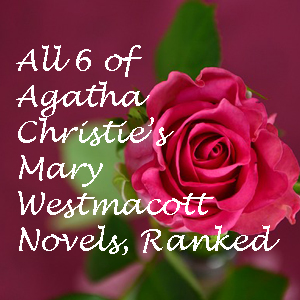Agatha Christie’s authorial career became fairly stable about a decade in, so she had the freedom to write non-mystery novels (sometimes called “mainstream” or “literary” novels). She chose to write these six novels under the pseudonym Mary Westmacott (she was outed after the fourth book) both to be free of pressure and to keep the reader free of genre expectations. It hurt the sales, but not the reviews, which actually tended to be more positive than the books written under her own name.
The pseudonym helped Christie be more comfortable writing about herself, as three of the Westmacotts are extremely autobiographical – as readers could tell once they had access to 1977’s “Agatha Christie: An Autobiography.” These are the first, second and fifth entries — “Giants’ Bread” (1930), “Unfinished Portrait” (1934) and “A Daughter’s a Daughter” (1952) – although the latter is an adaptation of her play of the same name, written in the 1930s.
In the third, fourth and sixth Westmacotts – “Absent in the Spring” (1944), “The Rose and the Yew Tree” (1948) and “The Burden” (1956) – Christie goes deep into the minds of original characters. This makes these books of less value to biographers looking for clues, but Christie expands her literary wings. The brilliant “Spring” and intriguing “Burden” are structurally unlike anything else she wrote. “Rose,” meanwhile, is as richly written as “Bread” and “Portrait” but avoids the “overstuffed” criticism by having three well-drawn characters meet at a fascinating intersection. A case could be made that it’s Christie’s best novel, period.
Here are my rankings of the six Mary Westmacott novels, all of which Christie aficionados should enjoy, as long as they don’t demand a whodunit. Click on each title for a full review.
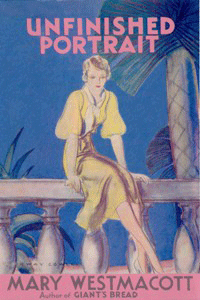
6. “Unfinished Portrait” (1934)
Although the names are changed to Celia and Dermot, this second-published Westmacott novel is a thinly veiled case of Christie working through the painful emotions of first husband Archie leaving her. One-to-one parallels to “Agatha Christie: An Autobiography” can be found in the narrative. We get insight into the 1910s and ’20s courtship procedure, wherein marriage proposals were akin to what a second date would be today, and the excellent early advice Christie/Celia gets from a publisher: Write what seems right to you, don’t burden your narrative with fact-based research. The framing mechanism wherein a kindly man listens to suicidal Celia’s life story in one night is not believable (especially since he’s surprisingly not one of the many people who wants to marry her). This is an overstuffed bildungsroman; other Westmacotts benefit from more specificity. Still, as a backdoor autobiography that’s more emotionally open that her actual autobiography, “Portrait” is essential for Christie scholars.
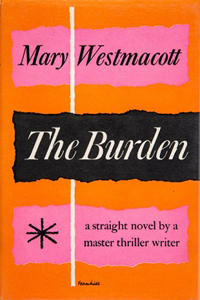
5. “The Burden” (1956)
Christie gets appealingly experimental with structure in the last Westmacott, as she writes three “books” of character studies – one of selfless Laura, one of needy younger sister Shirley, and one of an initially out-of-the-blue character, middle-aged Llewellyn. We know the latter will come into one of the women’s lives only because they are all in the same novel, but the question of which woman provides a fun mystery. Also, there is a poisoning in one segment of “The Burden,” making this the Westmacott that’s the closest to being a straight-ahead Christie. I rank it slightly low on the list because it repeats the “A Daughter’s a Daughter” theme of mutual over-reliance – except with a big sister and little sister rather than mother and daughter. But the story of ex-missionary Llewellyn, who “starts” his life at 40, provides a touch of magical realism that elevates everything.

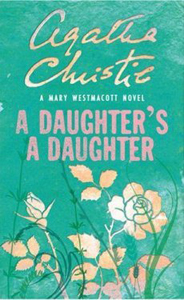
4. “A Daughter’s a Daughter” (1952)
This novel started off as a well-regarded play in the Thirties, drawn from worries about how her daughter Rosalind might react to Christie’s second marriage. The characters are widowed mother Ann and daughter Sarah, who is coming of age. The fifth Westmacott (but first to be published after the author’s identity was revealed) is like a dramatic, midcentury “Gilmore Girls”; the Prentice women’s closeness is their strength and their weakness. A strength because they always have a source of unconditional love, a weakness because every one of their decisions – namely about who to marry or not marry — factors in the other woman. As such, they reflect on their paths not taken and blame the other one deep down, even when telling themselves they shouldn’t. Christie spices up the tale with thoughtful supporting-character foils, including a longtime maid who is an understated, stable mother figure to both Ann and Sarah.
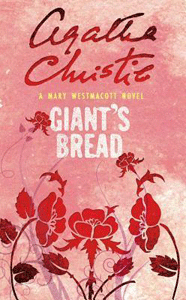
3. “Giants’ Bread” (1930)
In Christie’s first Westmacott novel (sometimes spelled “Giant’s Bread”), she gives most of the characters one of her own traits. Vernon’s happy childhood and Nell’s time as a nurse during World War I both come from Christie herself. Then she digs into paths not taken in her own life (the parallels can be found in “An Autobiography”) as Vernon struggles with a music career and Nell chooses to marry a rich man for the sake of a comfortable life. While “Bread” is notably more character-driven than her murder mysteries, Christie does include different kinds of melodrama, including amnesia (again lightly autobiographical), someone being mistakenly reported dead during the war, and a man being forced to choose on the spot between the two women he loves. Although overstuffed in the manner of a first (non-mystery) attempt, this is a melancholy, twisty bildungsroman about a man always struggling with imperfect options.
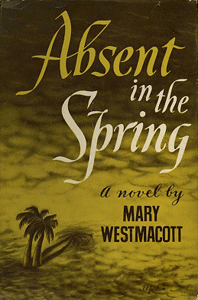
2. “Absent in the Spring” (1944)
The third Westmacott book quickly poured out of Christie and required little revision. This makes sense as it’s one of her shortest novels, it has no plot, and it only has one main character (whose point of view we follow most of the way). Drawing from her own perilous cross-desert journeys from England to the Middle East and back, Christie follows Joan Scudamore, a confident housewife who has all her ducks in a row and is judgmental on the inside about everyone who lives life differently from her. Some religious people go on sabbaticals to clear their mind, but here it is forced on Joan as she is stranded at a desert depot for a week with no English speakers, no reading material and eventually no writing paper. For the first time in her life, Joan can’t keep busy and instead thinks about her own nature, leading to epiphanies – and also to the author’s sharp insights into the honesties and fakeries of self-reflection.
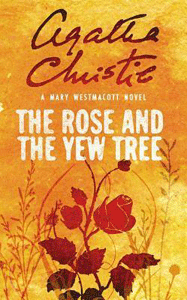
1. “The Rose and the Yew Tree” (1948)
Because Miss Marple is an elderly woman, people underestimate her and she’s able to observe human nature without affecting the experiment. Hugh Norreys, confined to a wheelchair and suicidal, also gains this power to observe people at his leisure in this fourth and best Westmacott book. He himself plays more of a role than Marple usually does: He’s one side of a love triangle that also includes opportunistic politician Gabriel and simple (but not stupid) Isabella. Christie robustly explores the oddity that humans can’t get into each other’s minds yet we nonetheless have a roughly agreed-upon universal “reality” against which all actions play out. The contrast between how a person is viewed and how they really are becomes dramatic in multiple arenas. First, in politics: The localized nature in a small English coastal town makes this Christie’s most grounded exploration of political gamesmanship (at the other end of the spectrum is “Passenger to Frankfurt,” her worst book). Second, in love: “Rose” is among Christie’s most honest portrayals of a rather cruel – but occasionally beautiful — aspect of life that no one can quite escape.
Sleuthing Sunday reviews an Agatha Christie book or adaptation. Click here to visit our Agatha Christie Zone.
Image of rose by congerdesign from Pixabay.

